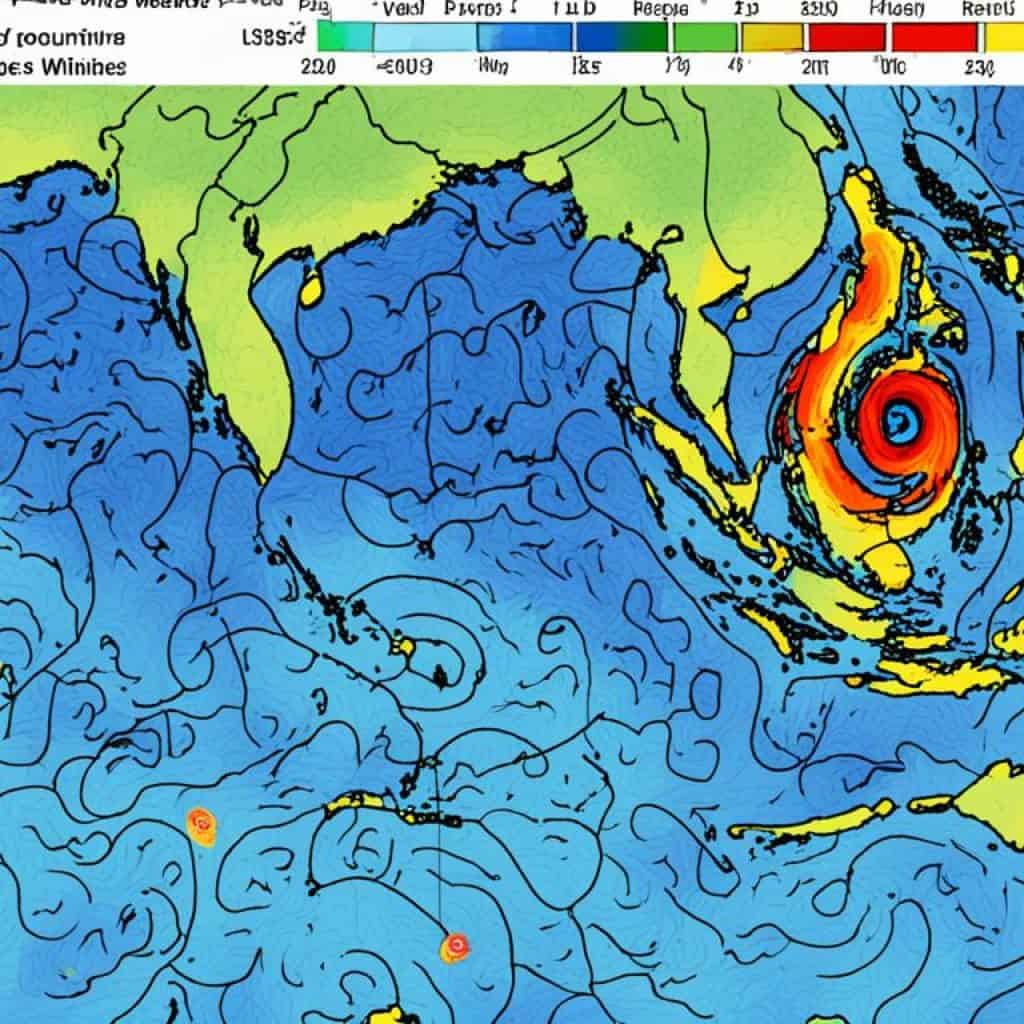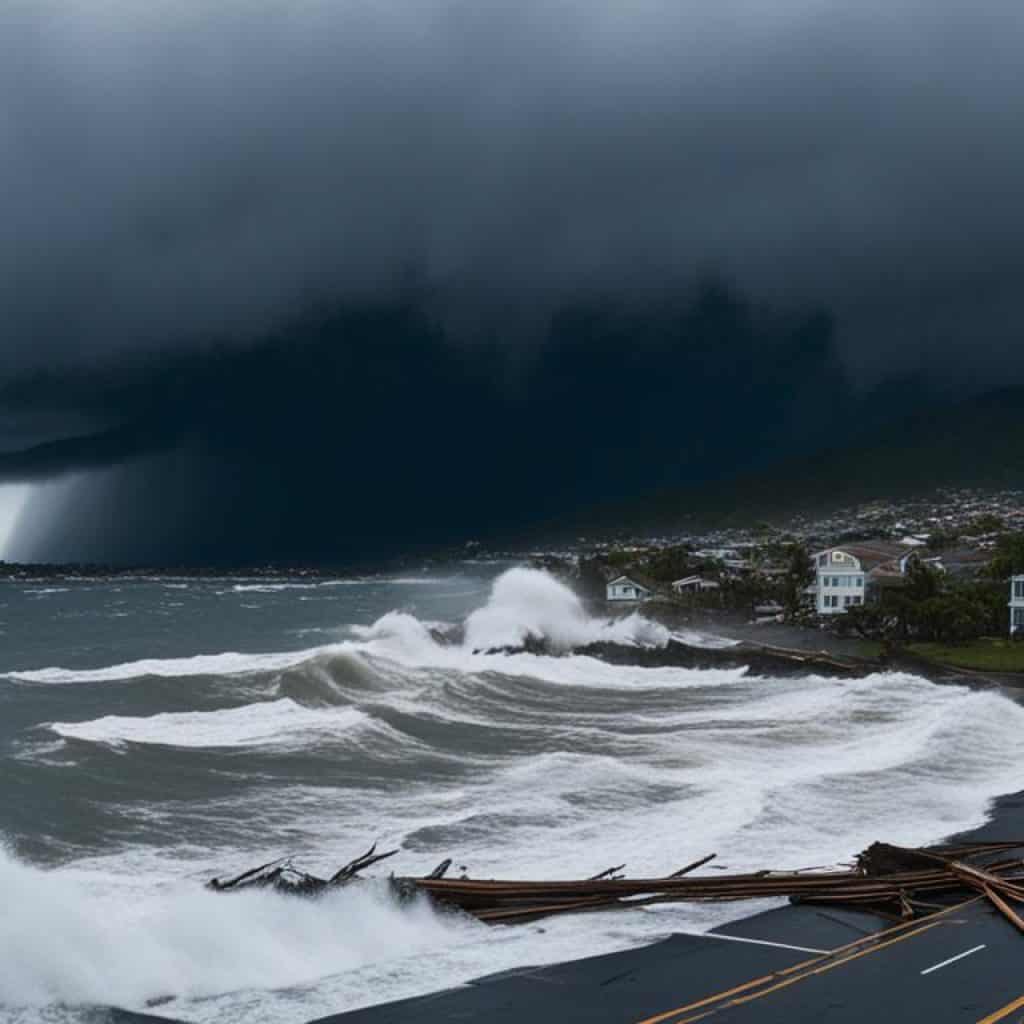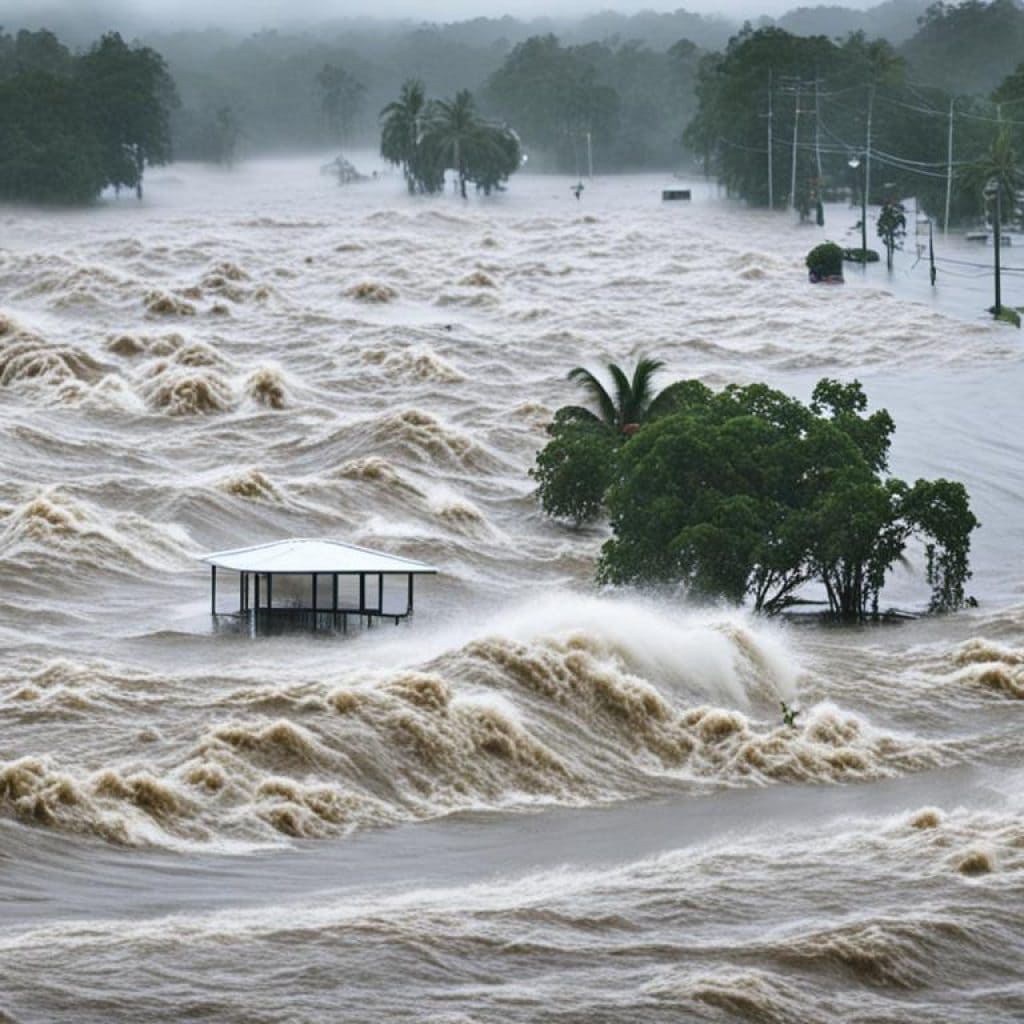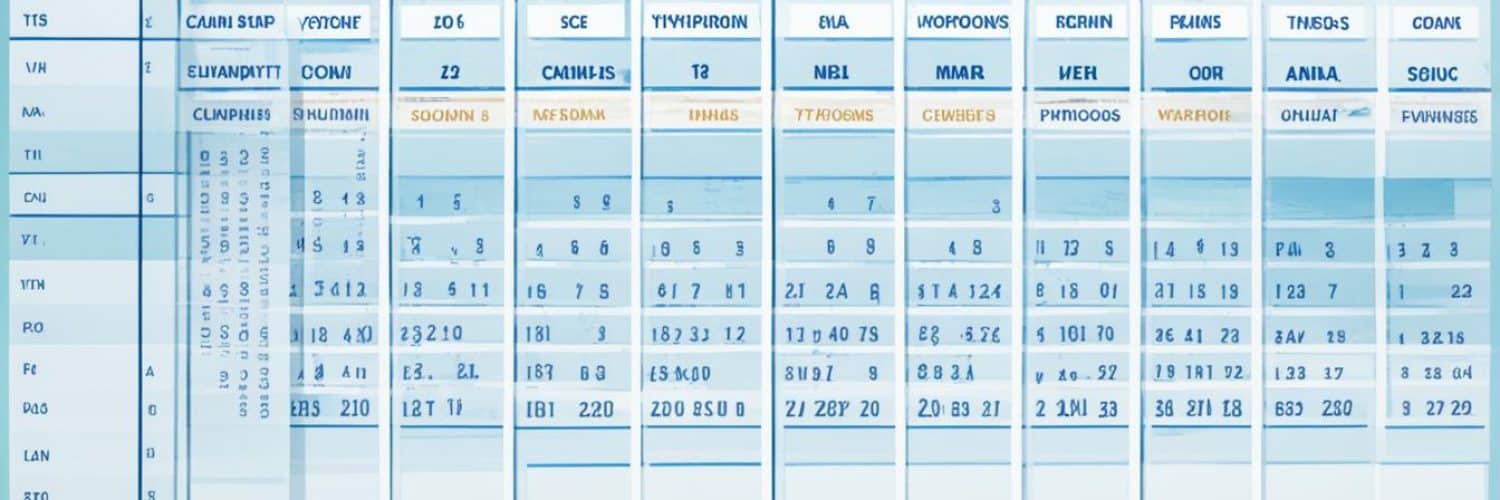As the 2024 typhoon season approaches, it’s important to stay informed and prepared. The Philippines is no stranger to these powerful storms, and each year brings its own set of challenges. Are you aware of the potential dates and tracks of the typhoons that will impact the region? Do you know what steps to take to ensure the safety and readiness of your family and community?
In this article, we will provide you with a comprehensive list of typhoons expected to hit the Philippines in 2024, along with their dates and projected paths. By staying up-to-date on this information, you can take the necessary precautions to protect yourself and your loved ones.
Key Takeaways:
- Stay prepared for the 2024 typhoon season in the Philippines.
- Track the dates and paths of typhoons to ensure your safety.
- Follow the guidance of local authorities and take necessary precautions.
- Stockpile essential supplies and have an emergency plan in place.
- Stay informed about any updates or changes in the weather conditions.
Typhoon Doksuri (Egay)
Typhoon Doksuri, also known as Egay in the Philippines, is one of the first typhoons expected in 2024. This powerful storm is forecasted to intensify as it tracks west-northwestward in the Philippine Sea.
On its projected path, Typhoon Doksuri will make a close approach to the Babuyan Islands in Cagayan Province before entering the vast expanse of the South China Sea. While it is projected to weaken slightly, it is expected to maintain typhoon conditions as it passes south of Taiwan.
Finally, Typhoon Doksuri is forecasted to make landfall in Fujian Province, mainland China, posing potential risks to this region.
Stay prepared and informed about Typhoon Doksuri (Egay) to ensure the safety and well-being of yourself, your loved ones, and your community.
“Being aware of the trajectory and intensity of Typhoon Doksuri (Egay) is essential in making informed decisions and taking necessary precautions to protect yourself and your community.”
Tropical Cyclone Wind Signals and Rainfall
The Philippine Atmospheric, Geophysical, and Astronomical Services Administration (PAGASA) has issued Tropical Cyclone Wind Signals for various regions in the Philippines due to Typhoon Doksuri. These signals indicate the strength of the winds expected in those areas.
Additionally, rainfall totals are forecasted for different provinces, with some areas expected to receive 5-10 cm of rainfall and others possibly experiencing more than 20 cm.
The regions affected by these signals and rainfall include:
| Provinces |
|---|
| Cagayan |
| Catanduanes |
| Camarines Sur |
| Camarines Norte |
| Sorsogon |
| Batanes |
| Ilocos Norte |
| Ilocos Sur |
| Apayao |
| Abra |
| La Union |
Stay informed about the Tropical Cyclone Wind Signals and rainfall totals in these regions to take necessary precautions and ensure the safety of you and your loved ones.
Potential Impacts and Advice
The inclement weather associated with Typhoon Doksuri can have significant impacts on the affected areas. It is essential to be aware of these potential consequences and take appropriate measures to protect yourself and your community.
Flooding
Heavy rainfall from the typhoon can result in flooding, particularly in low-lying areas. This can lead to road closures, property damage, and disruption of essential services. It is crucial to stay informed about flood alerts and evacuate if necessary. Avoid driving or walking through flooded areas, as the water may be deeper or more powerful than it appears.
Evacuations
In situations where the safety of residents is at risk, localized evacuations may be implemented. If you receive an evacuation order, it is crucial to comply and follow the instructions of local authorities. Prepare an emergency kit containing essential items such as food, water, medications, and important documents in case evacuation becomes necessary.
Flight Disruptions
Typhoon Doksuri can cause flight disruptions, including delays and cancellations. If you have travel plans during the typhoon period, monitor the status of your flight closely and stay in contact with your airline for updates. Make alternative arrangements if needed and ensure your safety takes precedence over travel plans.
Power Outages
The strong winds and heavy rainfall associated with the typhoon can result in power outages. Prepare for potential power disruptions by ensuring you have a supply of flashlights, batteries, and alternative sources of power, such as a generator. Charge mobile devices in advance to stay connected during outages.
Insect-borne Diseases
Stagnant water from flooding can create suitable breeding grounds for mosquitoes, increasing the risk of insect-borne diseases such as dengue fever and malaria. Take precautions to prevent mosquito bites by using insect repellent, wearing protective clothing, and keeping windows and doors closed or screened. Remove any standing water around your home to eliminate breeding sites.
Waterborne Diseases
Contaminated water sources during flooding can lead to the spread of waterborne diseases like cholera and leptospirosis. Avoid consuming tap water unless it has been properly treated or boiled. Practice good hygiene by washing hands with clean water and soap or using hand sanitizer when clean water is not available. Avoid contact with floodwater to minimize the risk of infection.
By being aware of these potential impacts and following the advice provided, you can better protect yourself and minimize the risks associated with Typhoon Doksuri. Stay tuned to local authorities, follow safety instructions, and prioritize your well-being and the well-being of your community.
Tracking Tropical Cyclone 09W (Goring)
Tropical Cyclone 09W, also known as Goring, is another system to monitor in 2024. It is currently moving northwestward over the Philippine Sea, east of Basco, Batanes.
The impact of 09W includes severe winds and the possible enhancement of the Southwest Monsoon.
The system is expected to track west-southwestward and then turn southward along the eastern coast of Cagayan Valley. This trajectory could result in occasional rains over western portions of Luzon.
To visualize the forecasted path of Tropical Cyclone 09W, refer to the image below:
| Region | Forecasted Impact |
|---|---|
| Cagayan Valley | Severe winds, possible rains |
| Luzon (western portions) | Occasional rains |
Monitoring the trajectory and potential impact of Tropical Cyclone 09W (Goring) is crucial to ensure the safety and preparedness of affected areas. Stay updated with the latest updates from meteorological authorities and follow their guidance to protect yourself and your community.
Forecasted Intensity and Typhoon Wind Signals
Tropical Cyclone 09W is predicted to steadily intensify in the next 36 hours, potentially reaching severe tropical storm category. There is even a possibility for it to escalate to typhoon category and potentially become a super typhoon in the coming days. As of now, there are no Typhoon Wind Signals hoisted, but this may change depending on the changes in the extent of the tropical cyclone winds over areas in Northern Luzon.

Typhoon Wind Signals play a crucial role in alerting and informing the public about the expected wind conditions associated with a typhoon. These signals are essential in helping individuals and communities prepare accordingly, particularly in regions that may experience strong winds and potential hazards. Monitoring and staying updated with the latest Typhoon Wind Signals issued by the relevant authorities can aid in making informed decisions and taking appropriate safety measures.
Hazards and Potential Impacts of 09W
Although Tropical Cyclone 09W is currently not expected to bring heavy rainfall to the Philippines over the next three days, there is a possibility of a westward shift in its track forecast. Such a shift could result in heavy rainfall over portions of Cagayan Valley, posing potential hazards.
In addition to heavy rainfall, the enhanced Southwest Monsoon may lead to gusty conditions in southern Luzon, Visayas, and Mindanao. These conditions could cause disruptions and impact the affected areas.
Furthermore, severe winds associated with Tropical Cyclone 09W could cause moderate damage, particularly in coastal and upland/mountainous regions. It is important to take necessary precautions and stay prepared for potential wind-related hazards.
As with any tropical cyclone, the path and intensity of 09W may change, so it is crucial to stay updated with the latest weather advisories and follow the guidance of local authorities.
Summary of Hazards and Potential Impacts:
- Heavy rainfall over Cagayan Valley if a westward shift in track forecast occurs.
- Gusty conditions in southern Luzon, Visayas, and Mindanao due to enhanced Southwest Monsoon.
- Moderate damage from severe winds, especially in coastal and upland/mountainous areas.
Be Prepared and Stay Safe:
“In the face of potential hazards, it is vital to stay informed and take all necessary precautions to protect yourself, your loved ones, and your property. Stay updated on the latest weather forecasts and advisories, secure loose objects, and have an emergency preparedness plan in place. Remember, your safety is the top priority.”
| h3: | Detailed Hazards and Potential Impacts |
|---|---|
| Heavy Rainfall | Possible heavy rainfall over portions of Cagayan Valley due to track forecast changes |
| Gusty Conditions | Potential for enhanced Southwest Monsoon to bring gusty conditions in southern Luzon, Visayas, and Mindanao |
| Severe Winds | Moderate damage from severe winds, particularly in coastal and upland/mountainous areas |
Seasonal Summary of the 2023 Pacific Typhoon Season
The 2023 Pacific typhoon season was characterized by low activity and a relatively inactive typhoon season. Despite the low number of named storms, the season witnessed the formation of several destructive storms, including Typhoon Doksuri and Typhoon Haikui.
“Despite the inactive typhoon season in 2023, the impact of Typhoon Doksuri was devastating.”
“Typhoon Doksuri struck the northern Philippines, Taiwan, and China, causing widespread destruction and loss of life.”
Typhoon Doksuri unleashed its destructive power on multiple regions, leaving a trail of devastation in its wake. The storm affected the northern Philippines, Taiwan, and China, causing significant damage to infrastructure, agriculture, and homes.
Another notable storm during the 2023 Pacific typhoon season was Typhoon Haikui. This powerful typhoon made landfall in China and Hong Kong, resulting in severe flooding and widespread disruption.
Although the overall activity of the 2023 typhoon season was subdued, these destructive storms serve as a reminder of the unpredictable nature of typhoons and the importance of preparedness and mitigation efforts.

| Typhoon Name | Regions Affected | Impact |
|---|---|---|
| Typhoon Doksuri | Philippines, Taiwan, China | Widespread destruction and loss of life |
| Typhoon Haikui | China, Hong Kong | Severe flooding and disruption |
Season Duration and Agencies
The Pacific typhoon season typically spans the entire year, with most tropical cyclones forming between May and October. This extended season brings with it the need for diligent monitoring and forecasting. Multiple agencies are responsible for tracking and providing information about typhoons.
Japan Meteorological Agency (JMA)
The Japan Meteorological Agency (JMA) plays a crucial role in naming and categorizing typhoons based on sustained wind speeds. Their expertise and advanced technology help in accurate predictions and timely warnings.
Philippine Atmospheric, Geophysical and Astronomical Services Administration (PAGASA)
The Philippine Atmospheric, Geophysical and Astronomical Services Administration (PAGASA) closely monitors cyclones within the Philippine Area of Responsibility (PAR). They assign names to these cyclones, ensuring efficient communication and preparedness among the local communities.
Joint Typhoon Warning Center (JTWC)
The Joint Typhoon Warning Center (JTWC) is an agency responsible for tracking and classifying tropical depressions. By assigning numbers to these depressions, they enhance the ability to track and provide accurate information about potential typhoons.
With the combined efforts of these agencies, the Pacific region receives timely and reliable alerts, allowing communities to prepare, and authorities to take necessary precautions to minimize the impact of tropical cyclones.
Seasonal Forecasts and Predictions
The 2024 Pacific typhoon season is expected to bring a significant number of tropical storms, typhoons, and intense typhoons. Several organizations have released forecasts and predictions to provide insights into the upcoming season. These forecasts are essential for preparedness and response efforts, allowing communities to better understand the potential risks and take necessary precautions.
One of the forecasting entities, the Tropical Storm Risk (TSR) Consortium, has predicted above-average activity for the season. This suggests that there may be a higher number of tropical storms and typhoons compared to the long-term average. The TSR forecasts serve as a valuable tool for understanding the overall intensity and impact of the upcoming typhoon season.
In addition to the TSR forecasts, the Philippine Atmospheric, Geophysical, and Astronomical Services Administration (PAGASA) has provided specific forecasts for different periods of the 2024 typhoon season. PAGASA’s forecasts offer localized insights into the expected number of tropical storms, typhoons, and intense typhoons during specific timeframes. These forecasts enable communities to plan and allocate resources accordingly, ensuring the safety of residents and minimizing the potential impact of these weather events.
To further assess the intensity and severity of the typhoon season, meteorologists and researchers often refer to the Accumulated Cyclone Energy (ACE) index. This index quantifies the total energy generated by tropical storms and typhoons throughout the season. By analyzing the ACE index, forecasters can estimate the potential destructive power of the upcoming typhoon season.
Summary of Seasonal Forecasts and Predictions:
| Forecasting Entity | Average Tropical Storms | Average Typhoons | Average Intense TCs | ACE Index |
|---|---|---|---|---|
| Tropical Storm Risk (TSR) Consortium | Above average | Above average | Above average | N/A |
| Philippine Atmospheric, Geophysical, and Astronomical Services Administration (PAGASA) | Varies by forecast period | Varies by forecast period | Varies by forecast period | N/A |
As the typhoon season unfolds, it is crucial to stay updated on the latest forecasts and predictions provided by reliable sources like TSR and PAGASA. This will enable individuals, communities, and relevant authorities to make informed decisions, implement proactive measures, and ensure the safety and well-being of everyone affected by these powerful weather phenomena.
Tropical Depression Amang
The 2024 typhoon season in the Philippines began with Tropical Depression Amang, which formed in April. This tropical depression made landfall in the Philippines, bringing with it strong winds and heavy rainfall.
As Amang traversed the country, it caused significant agricultural damages, impacting the livelihoods of farmers and communities. The strong winds and torrential rains resulted in flooding and landslides, further exacerbating the agricultural losses.
The severe weather conditions associated with Tropical Depression Amang also led to suspensions in sea travel, as it posed risks to maritime transportation. The Philippine Coast Guard and other authorities implemented safety measures to ensure the well-being of travelers.
In addition, class suspensions were implemented in affected areas to prioritize the safety of students and school personnel. This allowed communities to focus on necessary evacuation and preparation efforts, minimizing the potential risks posed by the tropical depression.
The impact of Tropical Depression Amang serves as a reminder of the importance of early warning systems and preparedness measures. Organizations like PAGASA play a crucial role in monitoring and providing timely updates to safeguard the well-being of individuals and communities in the face of such weather events.
| Effects of Tropical Depression Amang | Measures Taken |
|---|---|
| – Agricultural damages | – Suspension of sea travel |
| – Flooding and landslides | – Class suspensions |
| – Disruptions in livelihoods |
It is crucial for individuals and communities to stay informed and heed the guidance of local authorities during tropical depressions and other severe weather events. By taking necessary precautions and working together, we can minimize the impact of such events and ensure the safety and well-being of everyone.

Tropical Storm Sanvu
Tropical Storm Sanvu, a weather system that developed in April, had a significant impact on Guam. The storm brought gusty winds and resulted in power outages across the island. However, Sanvu weakened over the course of a few days and eventually dissipated.
This episode highlights the importance of preparedness and response measures in regions prone to tropical storms. Communities in Guam must be equipped with emergency supplies and have contingency plans in place to mitigate the effects of power outages and other challenges caused by such weather events.
Typhoon Mawar (Betty)
Typhoon Mawar, also known as Betty, was a powerful storm that impacted Guam and later moved towards Okinawa. This super typhoon caused significant destruction and posed a threat to the affected areas.
The residents of Guam braced themselves as Typhoon Mawar approached. The storm brought heavy rains, strong winds, and storm surges, leading to widespread damage to infrastructure and homes.
“We have never experienced such a powerful typhoon before. It was a terrifying ordeal,” said a resident of Guam.
After its impact on Guam, Typhoon Mawar started moving towards Okinawa. The local authorities in Okinawa issued warnings and evacuation orders to ensure the safety of their residents.
Fortunately, as it moved closer to Okinawa, Typhoon Mawar underwent an extratropical transition. This transition caused the storm to weaken and lose its tropical characteristics.
The extratropical transition of Typhoon Mawar resulted in a change in its structure and behavior, reducing the immediate threat to Okinawa. However, residual impacts such as heavy rainfall and gusty winds were still expected.
The experience of Typhoon Mawar serves as a reminder of the unpredictable nature of these natural disasters. Being prepared and following the guidance of local authorities can significantly reduce the risks and ensure the safety of individuals and communities.
Conclusion
The 2024 typhoon season in the Philippines is shaping up to be a challenging one, with the forecast predicting the arrival of several storms with varying intensities. To navigate these tumultuous times, it is crucial to stay informed about the List Of Typhoons In The Philippines 2024 With Dates and track the movement of these storms through reliable sources like Typhoon Tracker 2024. By doing so, you can ensure the safety and well-being of your loved ones and communities.
As the Typhoon Seasons Philippines unfold, it is essential to heed the advice and guidance of local authorities. Keep a close eye on Cyclone Forecast Philippines updates and take necessary precautions to protect yourself and your surroundings. Be prepared by stocking up emergency supplies, securing your home, and having a clear evacuation plan in place.
FAQ
What is the typhoon season in the Philippines in 2024?
The typhoon season in the Philippines in 2024 is expected to bring several storms with varying intensities and impacts.
What is Typhoon Doksuri (Egay)?
Typhoon Doksuri, also known as Egay in the Philippines, is one of the typhoons expected in 2024. It is projected to intensify and track west-northwestward in the Philippine Sea before making landfall in mainland China.
Are there any Tropical Cyclone Wind Signals and Rainfall forecasts?
Yes, the Philippine Atmospheric, Geophysical, and Astronomical Services Administration (PAGASA) has issued Tropical Cyclone Wind Signals for various regions in the Philippines due to Typhoon Doksuri. Rainfall totals of 5-10 cm are forecasted for certain provinces, while others may experience more than 20 cm of rainfall.
What are the potential impacts and advice for typhoon-related hazards?
The inclement weather associated with Typhoon Doksuri can lead to flooding, localized evacuations, flight disruptions, power outages, and an increased risk of insect-borne and waterborne diseases. It is important to follow evacuation orders, stockpile essential supplies, and take necessary precautions to protect against potential health hazards.
What is Tropical Cyclone 09W (Goring)?
Tropical Cyclone 09W, also known as Goring, is a system to monitor in 2024. It is currently moving northwestward over the Philippine Sea and is expected to track west-southwestward before turning southward along the eastern coast of Cagayan Valley.
What is the forecasted intensity and Typhoon Wind Signals for 09W?
Tropical Cyclone 09W is forecasted to steadily intensify and may reach severe tropical storm category within the next 36 hours. There are no Typhoon Wind Signals hoisted at the current time, but they may be issued over areas in Northern Luzon depending on the changes in the extent of tropical cyclone winds.
What are the hazards and potential impacts of 09W?
Tropical Cyclone 09W is less likely to bring heavy rainfall to the Philippines in the next three days. However, any westward shift in its track forecast could result in heavy rainfall over portions of Cagayan Valley. Severe winds could cause moderate damage, especially in coastal and upland/mountainous areas.
What was the summary of the 2023 Pacific typhoon season?
The 2023 Pacific typhoon season was considered one of the least active seasons on record in terms of the number of named storms. However, it was still very destructive due to storms like Typhoon Doksuri and Typhoon Haikui.
When does the Pacific typhoon season typically run and which agencies monitor it?
The Pacific typhoon season typically runs throughout the year, with most tropical cyclones forming between May and October. It is monitored by agencies such as the Japan Meteorological Agency (JMA), the Philippine Atmospheric, Geophysical and Astronomical Services Administration (PAGASA), and the Joint Typhoon Warning Center (JTWC).
What were the seasonal forecasts and predictions for the 2023 Pacific typhoon season?
The Tropical Storm Risk (TSR) Consortium predicted above-average activity for the 2023 Pacific typhoon season. PAGASA also made specific forecasts for different periods of the season, providing valuable information for preparedness and response efforts.
What were the notable storms in the 2023 Pacific typhoon season?
The season started with Tropical Depression Amang, which made landfall in the Philippines, causing agricultural damages and disruptions in sea travel. Tropical Storm Sanvu affected Guam, causing power outages and bringing gusty winds. Typhoon Mawar, also known as Betty, impacted Guam and later moved towards Okinawa, reaching super typhoon status before undergoing an extratropical transition.
How can I stay prepared and ensure the safety of my loved ones during the typhoon season?
Source Links
- https://crisis24.garda.com/alerts/2023/07/philippine-sea-typhoon-doksuri-tracking-west-northwestward-east-of-the-philippines-as-of-early-july-24-update-2
- https://reliefweb.int/report/philippines/philippines-flash-update-1-tropical-cyclone-09w-goring-philippines-24-august-2023
- https://en.wikipedia.org/wiki/2023_Pacific_typhoon_season


















Add comment